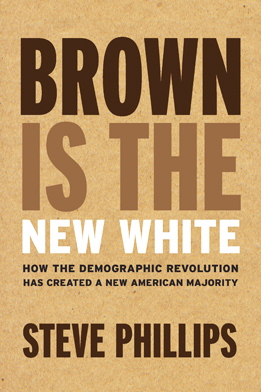|
Brown is the New
White
by Steve Phillips
c.2016, The New Press
$25.95 / $30.95 Canada
249 pages
By Terri Schlichenmeyer
The Truth Contributor
Your vote matters.
At least that’s what they tell you, but you have your
doubts. You’re ONE of millions of people who’ll go to the
polls in November. You’re a raindrop in the sea, a needle in
a voting haystack. But as you’ll see in Brown is the
New White by Steve Phillips, you are more powerful
than you think.
In 1968, the year Martin Luther King was assassinated, about
12 percent of the U.S. population comprised “people of
color.” Forty years later, on the night that Barack Obama
was elected president, 36 percent of Americans were African
American, Latino, Asian American, Arab American, or Native
American.
|
 |
|
While that still doesn’t sound like a very high number,
Phillips says that, for a politician looking to win in 2016,
those demographics belie an “equation that’s been hiding in
plain sight”: add progressive white voters, and “America
has a progressive, multiracial majority right now…”
That’s good news for Democrats – the party most often
favored by progressives and people of color – but it’s not
the final word. Drawing a line from Selma to Obama’s
election, Phillips says that understanding the interests and
histories of each individual group (including progressive
whites) is essential for forward movement, politically. It’s
also important to know how those groups vote and the issues
they care about, because if the “truth of the lives of the
New American Majority” is ignored, “they will ignore you…”
Phillips says. Stirring things up, as he points out, are
conservatives who actively court “communities of color” and
Republicans who’ve shown that they’re trying to embrace new
thinking.
Smart politicians, Phillips says, will “invest wisely” by
speaking directly through media outlets that are important
and relevant to voters in order to keep the New American
Majority’s attention and retain their support. Both parties
must examine ways to bring “justice” and, therefore,
equality to constituents. They need to cultivate “great
cultural competence and expertise.” And they’ll have to
“educate themselves about the realities of the lives of
people of color.”
Jam-packed with statistics, numbers, and thoughts that whirl
around the pages, Brown is the New White is
interesting, but it’s not a book to finish in a weekend.
There’s so much inside here to comprehend, that you may not
even finish it this month.
Author Steve Phillips pulls together plenty of intriguing
ideas, history, and cause-and-effect tales but too many
stats, which often muddy his points. He seems to go
off-topic, sometimes slightly, but enough to cause me to
stop and wonder where this was going. And yet, what he says
is compelling and impossible to ignore; to wit, we are on
the verge of something that could be exciting, if we only
coalesce.
To reach that point, there are suggestions here, some of
which may be controversial and some of which will require
serious work. Still, though this book is definitely on the
heavy side, what you’ll eventually learn is meaningful,
particularly in this election year. For anyone over 18,
Brown is the New White could be a book that matters.
|